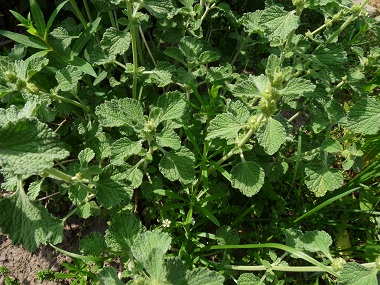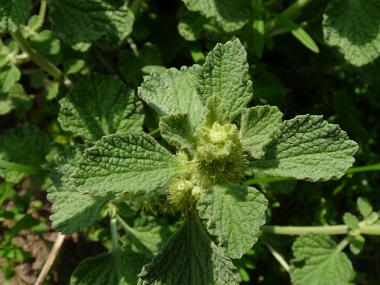




To support our efforts please browse our store (books with health benefits, etc.).
Horehound is derived from "Horus", the Egyptian god of sky and light. For centuries, herbalists have prescribed this edible weed for fevers, malaria and especially for coughs. This is a perennial plant known more for its medicinal purposes than a food source. Although it can be consumed, it is highly recommended that this not be done on a regular basis, but only once in awhile.
Horehound as occasional food or as an herbal remedy is not to be taken during pregnancy or while nursing. Higher consumption can cause cardiac arrhythmia or an irregular heartbeat. In larger quantities it may also cause diarrhea or an upset stomach.
Distinguishing Features
Horehound is a bushy plant producing numerous annual, quadrangular and branching stems. It grows between 30 and 40 centimetres in height and has unique crinkled leaves that emit a bitter scent. Blooming season can range from April to October depending on geographic location and flowers do not appear on this plant until its second or third year.
Flowers
Flowers are white and are spiral-like positioned in the space between a leaf or branch and the stem. Its does not appear on the plant until the second or third year of growth and blooms anywhere between April and October.
 Fields
of Nutrition has medicinal benefits and vitamin/mineral content of Horehound.
Fields
of Nutrition has medicinal benefits and vitamin/mineral content of Horehound.
Leaves
Leaves are unique as they are wooly and whitish-gray in colour and crinkled-looking. They have an extremely sharp aroma when crushed.
Height
Horehound generally grows to heights of 30 centimetres but depending on geographic location, it can grow taller.
Habitat
This is a hardy, wild edible plant that grows easily. It tends to do well in dry, well-drained soil, but adapts to most conditions. It will survive with little moisture (about 30 cm. of annual rainfall) and thrives in full sun. It grows along roadsides, in disturbed areas, fields and in semi-dry areas.
Edible Parts
Aerial parts are used. Leaves and the flowers can be added into a salad, stir-fry, soup or stew but only once in awhile. It should not be consumed as food on a regular basis. This is used more in herbal remedies to help eliminate occasional maladies. It is an immune booster so drinking a cup of horehound tea once a week can be beneficial. It tastes very bitter so adding honey to sweeten is recommended.
Other Name
White Horehound.
Similar Plants
Recipes
Winter Survival Food Handbook

PDF Plant Magazines
Types of Wild Food
Geographic Zones Seasons
Disclaimer
EdibleWildFood.com is informational in nature. While we strive to be 100% accurate, it is solely up to the reader to ensure proper plant identification. Some wild plants are poisonous or can have serious adverse health effects.
We are not health professionals, medical doctors, nor are we nutritionists. It is up to the reader to verify nutritional information and health benefits with qualified professionals for all edible plants listed in this web site. Please click here for more information.
Why Edible Wild Food?
- Food costs are rising
- Free, wild food is readily abundant
- Wild food adds nutrition to your diet
- Wild food can help treat various medical conditions





